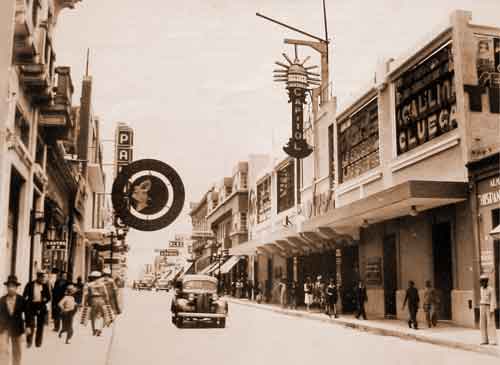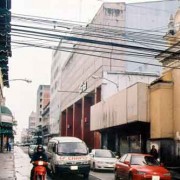One More Time Tunnel: El Capitol

Predecessor of Edificio Capitol, right, circa 1930; the long gone former Cine Capitol is on the left, across the street. (photo: Sergio Cruz Arteaga)
Thirty years ago metropolitan Guatemala had fewer than half its current 3.6 million people. Today’s well-heeled suburbs in its southeast quadrant were separated from El Centro by receding pastures and gardens. Zone One had long gone to seed, but in the late 1970s an attempt to return it to respectability was launched on Downtown’s main drag, Sexta avenida, between calles 12 and 13.
If you believe in ghosts, you might think that the people who lived on this block a century ago had a hand in this. Back then, there was a convent that was eventually abandoned and replaced by liquor markets and clothiers. It is rumored that the nuns are buried there because in 1977 workmen laying the foundation for a building on nearby 7a avenida encountered a Catholic catacomb. The other building became Incredible Hulk, an electronics retailer. When the Hulk went belly-up in 2001, its shell was absorbed by the Capitol Building that fronts 6a avenida.
So it is that today the Centro Comercio Capitol, or simply Los Cápitol, fills the block across from the Hotel Royal Palace. At its 1979 inauguration, it was anchored by what was still a new concept for the U.S., but bristling futurism for Guatemala—a Cineplex.
All of Guatemala’s better retailers responded by renting space on levels 2 and 3. Decades before Sears opened a department store in remote zone 11, they occupied most of level 4. Level 1, underground, was a retro-style movie house (the Cine Real) boasting carved wooden seating. To ensure the Capitol’s longevity as a draw for the affluent, it was built more sturdily than the spot’s previous edifices, condemned after the 1976 earthquake. Additionally, and consequently, the building not only has its own generators but its own well.Except out of curiosity—and even then only once—the moneyed folk never came. The nicer stores quickly fled south to zone 10’s Zona Viva and elsewhere—just as they had deserted Pasaje Rubio farther up the Sexta decades earlier. The few holdouts were hair salons, but these soon had competition and, today, level 3 is a Guiness-book concentration of clip joints. But it merits a look, even by the freshly clipped.
Level 3 is a corridor of striking mezzanines tiled with glass mosaics. It resembles gargantuan Star Trek transporters—in pleasant, sensory juxtaposition with the bouquet of shampoos. From the “transporter” rims you can spy the traffic of level 2, which has evolved or—if the nuns are still listening—degenerated into a hall of video arcades, pool halls, smoking, and general idleness. The arcades yield a deafening cacophony that leaks onto the street. The three upper levels, by contrast, are the Capitol’s engines of renaissance.
Level 4, formerly Sears, now houses the largest downtown branch of the Pais department-store chain, and some smaller shops that remain.
Level 5 was originally intended for parking. But few people who shop and play downtown have cars, so today it is a poor-man’s food court with bumper-cars in back and internet cafes in front.
The food court, the largest room anywhere in Zone One, has molded fiberglass seating in primary colors, as if kindergarten teachers had been consulted for the décor. Near the elevator landing, the walkway to the food court and arcade begins; from it, you can look out a huge window at a fine vista of Downtown Guatemala. Level 5 is, overall, assuring and eclectic, and soothing despite its noise. It is Zone One’s most public place under a roof.
Downtown web surfing, which began on level 5, now abounds in Zone One. Though many customers come to play games, students are lured by hourly rates that are half those of the Zona Viva.
Movies are cheaper, too; on Wednesdays, at the cines upstairs on level 6, tickets are half-off, so one can catch the big screen for about a dollar—with the “waterfall” next to the escalator thrown in. An irony of the Capitol’s evolution is that parking was at first atop the building, with the cinema in its bowels. Today, the parking is in the basement, and the eight chambers of the Cine Capitol roost up on level 6. A further irony is that the elegant carved pews of the old Cine Real have given way to utilitarian buckets.
People who visit Downtown are uncovering other signs of life: new museums, restored parks, art galleries and the occasional nice store. But no exploration is complete without a stop at the Sexta’s own time tunnel, Los Cápitol.

Pingback: September 2008 in Revue Magazine | Revue Magazine